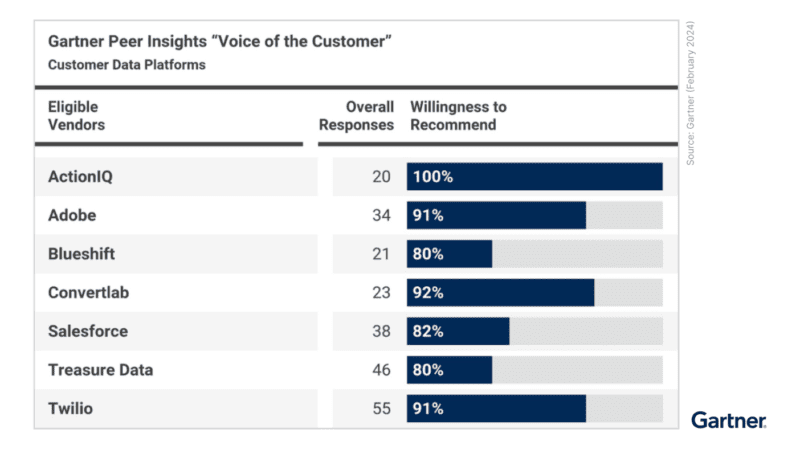Are Packaged CDPs Still Relevant in 2023?

Brands evaluating customer data platforms have likely seen ominous headlines about the death of traditional all-in-one packaged customer data platform (CDP) solutions and their inability to completely satisfy both technical and marketing teams within an enterprise.
Such statements are likely overblown, but they do help focus attention on challenges that brands have faced in the last several years of CDP implementations. Read on to learn more and download our CDP Market Guide for examples of packaged CDP providers — and alternative options.
What is a Packaged CDP?
A packaged CDP (also known as a bundled CDP) is a traditional all-in-one solution defined by industry analyst CDP Institute as “packaged software that creates a persistent, unified customer database that is accessible to other systems.”
These solutions combine infrastructure capabilities with business applications and aim to provide an end-to-end solution for collecting, unifying, segmenting, orchestrating and activating customer data.
For organizations who have made limited infrastructure investments or have significant gaps in any of the above areas, bundled CDPs can be a strong choice to deliver time-to-value and support business-critical use cases leveraging customer data. They are effective at key personalization and CX use cases and are designed for business usability first.
The weakness of this approach is that when major investments in data collection, unification and analytics have been made, a packaged CDP will be duplicative to parts of the existing stack. In addition, because a bundled CDP requires operating on a copy of data, it creates additional costs due to operational effort and cloud costs incurred when moving data — not to mention the additional security risk created by having another copy of data in the cloud.
Who Should Adopt a Packaged CDP?
So, are packaged CDPs still relevant in 2023? The answer, as with many technologies, is that it depends on your organization’s current capabilities and business goals.
For example, a bundled CDP may deliver great value to organizations in the following circumstances:
- Brands looking to accelerate data access to business teams with minimal effort
- Brands with limited existing investments in CX architecture, where a bundled solution can provide necessary capabilities without requiring extensive development work
- Organizations with multiple brands of varying martech sophistication, where a packaged CDP can provide immediate value by centralizing data and audiences
On the other hand, packaged CDPs may fail organizations in the following circumstances:
- Brands with mature tech stacks and deep infrastructure investments, where a bundled CDP would introduce redundant capabilities and unnecessary complexity
- Highly regulated organizations seeking maximum data security, where packaged CDPs would create many copies of sensitive data
How Should I Choose a Packaged CDP?
If a bundled CDP is right for your company, it’s important to pay attention to the two factors most important when evaluating one: What was it built for, and who was it designed for?
By understanding the original purpose of different offerings — and who their users were intended to be — you can determine both their core outcomes and their usefulness for your organization. For example, a tool designed to help IT teams unify customer profiles will prioritize the configuration of data flows at the expense of business-friendly audience segmentation and experience orchestration.
With this in mind, bundled CDPs can be sorted into five categories: consolidating customer data from multiple systems, managing identities, extracting insights from customer data, personalizing web experiences or enabling you to personalize omnichannel experiences with customer data.
Data Integration CDPs
- What they were built to do: Data integration CDPs were built to collect event data from digital applications and transmit it to other apps in real time to facilitate system integration and enable triggered communications.
- Who they were designed for: Data integration CDPs are aimed at developers and data engineers within IT to reduce in-house API development.
Known Identity Management
- What they were built to do: Identity management CDPs were built to collect, match and manage customer profiles from online and offline channels to deduplicate customer records and create a customer 360.
- Who they were designed for: Identity management CDPs are designed for data engineers and analysts on IT teams to define, manage and optimize identity resolution logic and stitch together customer data into a golden record.
Data Science
- What they were built to do: Data science CDPs were designed to create analytical models based on customer data to predict behavior.
- Who they were designed for: Data science CDPs are intended to be managed by analysts in charge of producing customer analytics and predictive insights. They’re constructed for analytics experts to accelerate the production of such insights via prepackaged models when there is not enough bandwidth for in-house model creation.
Web Personalization
- What they were built to do: Website personalization CDPs were built to personalize and optimize content for website and mobile application visitors.
- Who they were designed for: Website personalization CDPs are geared toward e-commerce professionals to manage content and offers across sites and apps while testing for optimization over time.
Experience Orchestration
- What they were built to do: Experience orchestration CDPs were built to scale personalized experiences across all online and offline touchpoints using customers’ full profile histories.
- Who they were designed for: Experience orchestration CDPs are designed for marketing, sales and customer service professionals to seamlessly provide personalized customer experiences across channels.
Learn More About the CDP Landscape
There has been a lot of hype about the death of packaged CDPs, but these solutions still offer value for organizations with limited investments in customer experience architecture. Packaged CDPs provide a fast and easy way to consolidate customer data, segment it, and personalize experiences, making them an effective tool for marketing teams.
Mature IT organizations with significant infrastructural investments and a need for greater flexibility may find these solutions to be duplicative and more expensive due to operational efforts and cloud costs.
When considering a CDP, it’s important to understand the different types available and to choose a solution based on your unique needs. Our CDP Market Guide is here to help you navigate the evolving CDP market. Download the guide to learn which approach to CDP selection is right for your business and how emerging features are redefining the CDP landscape.





